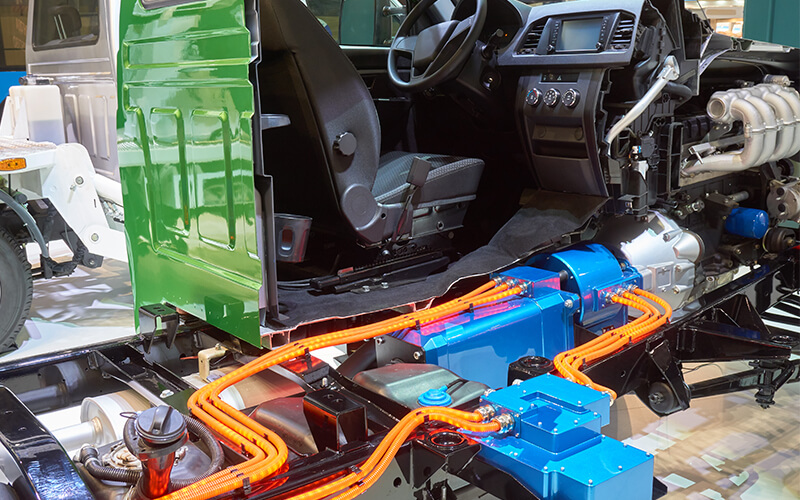Four Electronic Components in Commercial Electric Vehicle Anatomy
05/24/2023 //

The electrification of cars and trucks is in full flight. Increasing regulations for carbon reduction, global competition and consumer demand for decreased operating costs are three factors propelling electric vehicles (EVs) to approach 50 percent of the U.S. market share by 2030.
Although battery electric vehicles are a near-certainty to dominate light-duty automotive, the low-carbon drivetrain landscape for commercial vehicles is still evolving. Hydrogen is challenging commercial electric vehicles (CEVs) for share, given its increased competitiveness against heavy battery loads and extended driving range. But battery technology continues to improve, and electronics innovation is delivering the enhanced performance of battery commercial vehicles.
Four of these electronic components comprise the anatomy of a CEV: power electronics, energy storage systems, electronic control units (ECUs) and connectivity solutions.
The Heart: Power Electronics
Power electronics convert and regulate critical electrical energy to fuel vehicle systems. Recent advancements in power electronics have increased efficiency, reducing power loss from the battery. They also handle higher voltage and current loads to provide more power to electric motors while controlling speed and torque. Heavy payloads in CEVs amplify the need for increased efficiency to prevent range reduction. In addition, optimizing speed and torque while adding power from regenerative braking directs even more energy to extend the vehicle's range.
Inverters and converters are also enabling power electronics for battery CEVs. Inverters convert direct current (DC) from the battery into alternating current (AC) to power some electric motors. With DC-DC converters and AC-DC chargers, optimizing energy management and battery charging can extend the vehicle range, a critical metric for CEV technology adoption.
Power electronics enhancements address another major hurdle of CEVs: faster charge times. Handling higher voltage can enable level 2 and 3 charging, reducing the total time to charge from hours to minutes. Range and charge time have been historical drawbacks that have challenged the broad adoption of long-haul battery trucks.
The Backbone: Energy Storage Systems
Any battery solution has to have seamless energy storage. As the backbone of electric vehicles, the battery's energy density, cycle life and weight determine suitability for a given application. For CEVs, lithium-ion is still the dominant chemistry, though the development of lithium iron phosphate (LFP) and solid-state batteries is already underway. For example, Rivian has already switched its entire electric pickup lineup to LFP, leveraging its 2x amount of lifetime charges, improved environmental impact, reduced risk of thermal runaway and lower fabrication cost.
While LFP may not be energy-dense enough for CEVs, solid-state batteries may represent the best long-term battery chemistry through improved energy density, stability and performance. However, significant near-term challenges persist with solid-state, including manufacturing cost and scale hurdles engineers are yet to clear.
The Brain: Electronic Control Units (ECUs)
Perhaps the most crucial power electronics solution to enable CEVs is the ECU. These components are pivotal in vehicle performance by controlling and managing communication between the discrete vehicle systems. ECUs are especially important given the increased functionality electric vehicles handle due to the growing data the CEV collects. This trend has also led to more strict adherence to ISO 26262, which governs electronics safety in on-road vehicles.
ECU systems include lighting, autonomous driving features like LIDAR, RADAR, auxiliary cameras and advanced driver assist systems (ADAS). These functions have become increasingly sophisticated, increasing the need for operations to communicate. Control units also monitor and dictate adjustments to other parts of the vehicle's anatomy, like power electronics for regenerative braking or charge rate
By monitoring and adjusting key parameters such as motor torque, battery charge rate and regenerative braking, ECUs optimize CEV performance and support the driver simultaneously.
The Senses: Connectivity Solutions for Advanced Communication
Connecting vehicles is the next logical step as CEVs become more prevalent and critical to the decarbonization ecosystem. As a result, vehicle-to-everything (V2X) communication will be an increasingly important feature of commercial electric vehicles. V2X includes a range of technologies that allow vehicles to see and talk to infrastructure, smart devices and each other to enhance safety and efficiency on the road.
V2X can provide power resilience by creating a two-way electricity path between the vehicle and its surroundings. This feature enables a battery-powered CEV to take on a unique function as a mobile power source. The more seamlessly CEVs interface with their environment using their senses, the more benefits they can provide.
Takeaways
Electronics make up the anatomy of commercial electric vehicles. Each system plays a vital part in how the vehicle operates, and the success of commercial EVs depends on continued progress and innovation in each one.
As commercial electric vehicles gain market share and broad adoption, the demand for electronics innovation will only pull harder as businesses and governments push to meet stated decarbonization targets. It is critical to remain at the forefront of what the market wants to ensure the electronics' anatomy grows and matures quickly enough.
Adam Kimmel

Adam Kimmel has spent nearly 20 years as a practicing engineer, R&D manager and technical consultant. He has degrees in chemical and mechanical engineering, and is the principal and founder of ASK Consulting Solutions, a technical content writing and strategy firm.